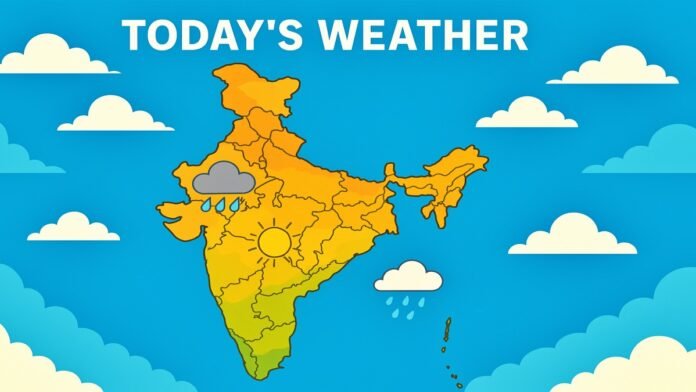
Key Points
- Delhi recorded its coldest morning of the season at 18.8°C on October 13, 2025, marking temperatures 2-3°C below normal
- Kashmir, Himachal Pradesh, and Uttarakhand witnessed the season’s first snowfall in early October, signaling early winter onset
- IMD predicts a 71% likelihood of a colder-than-average winter across India due to developing La Niña conditions
- Temperatures in Uttar Pradesh dropped significantly, with Kanpur recording 14.8°C, the chilliest morning of the season
- No rainfall expected in Uttar Pradesh and Bihar on October 13, with all districts placed in the green zone
- IMD forecasts above-normal rainfall of 115% in October across most parts of India, except northwest regions
New Delhi: A dramatic shift in weather patterns has swept across India, particularly affecting North India, with plummeting temperatures and unprecedented early snowfall in the Himalayan regions signaling the potential arrival of an early and severe winter season. The sudden weather transformation, characterized by increased humidity and sharp temperature drops over recent days, has caught residents off guard as they reach for woollens much earlier than usual.
Early Snowfall Transforms Himalayan Region
The Western Himalayan hill stations experienced their first snowfall of the 2025 season in early October, transforming popular tourist destinations into winter wonderlands. Gulmarg, Sonamarg, and Pahalgam in Jammu and Kashmir, along with Rohtang Pass in Himachal Pradesh, received significant snowfall, delighting tourists who never expected to witness snow in October. The snowfall at Gulmarg’s Kongdoori area pushed night temperatures below freezing point, while valley plains witnessed temperatures dropping 10 degrees below normal for this time of year.
Major mountain passes, including Sadhna Pass connecting Kupwara to Tangdhar, Razdan Pass linking Bandipore with Gurez, and Zojilla Pass connecting Kashmir with Ladak, have been closed due to heavy snow accumulation. Himachal Pradesh’s lower areas also experienced rainfall alongside snowfall in higher regions, leading to temperature drops affecting neighboring Punjab as well.
Delhi-NCR Experiences Season’s Coldest Morning
The national capital recorded its coldest morning of the season on Monday, October 13, 2025, with the Safdarjung Observatory registering a minimum temperature of 18.8°C, slipping below the 20-degree mark for the first time this season. The maximum temperature settled around 31°C, with the India Meteorological Department noting that temperatures are running 2-3°C below normal, indicating an early onset of winter-like conditions.
Clear skies and light northwesterly winds contributed to the morning chill, prompting Delhi residents to stop using coolers and air conditioners. Early mornings have seen people wearing sweaters and shawls, a sight typically reserved for late October or November. The IMD forecasts clear weather in Delhi until October 18, with maximum temperatures ranging between 32-33°C and minimum temperatures hovering around 19-21°C during this period.
La Niña Effect Threatens Severe Winter
The India Meteorological Department has issued warnings about a potentially severe winter across India, particularly in North India, due to the developing La Niña phenomenon. According to the US National Oceanic and Atmospheric Administration (NOAA), La Niña conditions are likely to persist through the Northern Hemisphere’s winter, with over 60% probability of continuing from November 2025 to January 2026.
The IMD’s Monsoon Mission Climate Forecasting System projections show increasing chances of La Niña formation between October and December 2025, which could result in below-average minimum temperatures with cold waves pushing 3-5°C lower than normal in Delhi-NCR. Experts from Skymet Weather and IMD predict this winter could rank among the coldest in recent years, with record lows across the Indo-Gangetic plains and residents in Delhi, Gurgaon, and Noida bracing for nights dipping below 10°C, foggy mornings, and potential travel disruptions.
The La Niña effect is expected to bring heavier snowfall in the Himalayas through active western disturbances, with the strongest impacts in Jammu and Kashmir, Himachal Pradesh, and Uttarakhand. However, IMD scientist Naresh Kumar clarified that the current temperature drop represents a temporary phase due to Western Disturbance, with skies expected to clear soon, marking a return to warmer days.
Uttar Pradesh Weather Outlook
On Monday, October 13, 2025, Uttar Pradesh is experiencing dry weather conditions with no possibility of rainfall. The Meteorological Department has placed all districts in the green zone, indicating clear skies across the state and relief from rain. However, temperatures continue to drop significantly, particularly during evening hours, necessitating special caution for children and the elderly.
The state capital Lucknow recorded a minimum temperature below 20°C, while Kanpur witnessed an even more dramatic drop to 14.8°C, making it one of the season’s chilliest mornings. The weather is expected to remain clear from October 13 through October 18, with no alerts issued for heavy rainfall or strong winds during this period. Residents are experiencing a double challenge with intense sunshine during daytime and mild cold during nights.
Bihar Weather Conditions
Bihar has also witnessed changing weather patterns with mornings and evenings turning cooler, though no rain alert has been issued for October 13, 2025. The Meteorological Department has included all districts in the green zone, with temperatures expected to exceed 30 degrees during the day but drop by evening. The slight chill in the morning and evening air has been attributed to rain and snowfall in northern Indian states last week.
According to the Meteorological Center in Patna, the monsoon withdrawal from the state is progressing gradually, with its effects expected to end in 3-4 days. Monday’s weather across the state is expected to remain generally dry, with partial cloud cover likely in some areas.
October Rainfall Predictions
The IMD has forecast above-normal rainfall for October 2025, predicting 115% of the long-period average of 75.4 mm across most parts of the country. This forecast attributes the increased precipitation to the development of low-pressure systems in the Bay of Bengal and Arabian Sea, along with intra-seasonal variability and other large-scale atmospheric processes.
However, some areas in northwest India, along with isolated pockets in the southern peninsula and northeast India, may experience normal to below-normal rainfall in October. The post-monsoon season (October to December) is expected to bring above-normal rainfall to most parts of the country, with the Northeast Monsoon rainfall over south peninsular India likely to exceed 112% of the long period average of 334.13 mm.
Heavy to very heavy rainfall is predicted for southern states, including Kerala, Tamil Nadu, Karnataka, and Andhra Pradesh, between October 12-17, while eastern states like Odisha, West Bengal, and northeastern states may also witness scattered rainfall during this period.
Regional Impact and Precautions
The sudden weather change and early winter signals pose significant challenges for vulnerable populations, including the elderly, homeless individuals, and farmers. The intense cold threatens frost damage to crops like wheat and mustard, particularly in the Indo-Gangetic plains. Travel disruptions are expected in hilly areas due to snowfall and slippery road conditions, with several high mountain passes already closed to vehicular traffic.
Air quality remains a concern in Delhi-NCR, with the AQI slipping into the ‘poor’ category in several areas due to stubble burning in neighboring states. Experts warn that pollution levels may deteriorate further in the coming weeks as wind speeds decrease, coinciding with the temperature drop. The IMD advises fishermen to avoid venturing into the sea from October 12-16 due to strong waves and storms in the Andaman Sea, Bay of Bengal, and Arabian Sea.
While the severe winter poses immediate challenges, meteorologists note a silver lining as La Niña often paves the way for stronger monsoons the following year, potentially boosting water reserves and improving crop yields. The cooler northern winters could also mean fewer extreme summer heatwaves, though coastal states may experience more cyclones during this period.



















































